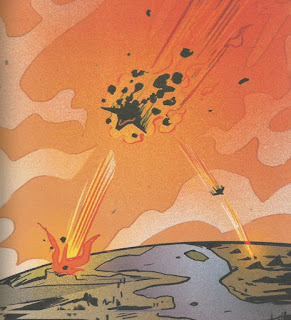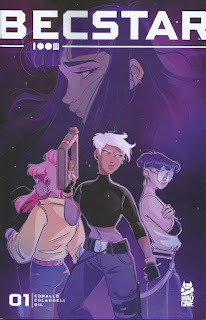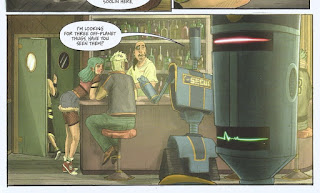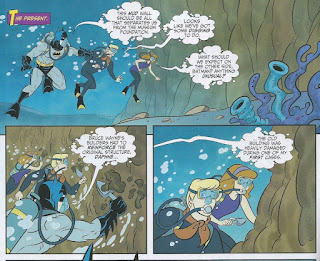Pick of the Brown Bag
May 25, 2021
by
Ray Tate
Welcome to the Pick of the Brown Bag. For those who came here by accident, my name is Ray Tate. I review comic books. Maybe you heard of me from the usenet, Silver Bullet Comics or its transformation Comics Bulletin. Doesn't matter. I'm now nestled here at my own blog.
I review everything that piques my interest. I have a backlog of comic books to read and review. So if you don't see a title or issue featured, it doesn't necessarily mean I've ignored it. It may mean I haven't gotten to it yet.
I'm catching up alphabetically, mostly. If I can make associations for special POBB posts, I'll do that. If I can read a comic book that's just come out of the gate, I'll do that as well.
This week it's a pair of brand new science fiction independent subjects: Black Star and Becstar. If you haven't time for the blog, check me out on Twitter: #PickoftheBrownBag.
Let me get this out of the way first. Apart from the name, these books share nothing but the genre in common. I didn't pair them together to compare and contrast. I just happened to read them at the same time and noticed the star name. No other reason.
Black Star published by Abrams is a reasonably priced, perfectly-sized, hardback graphic novel by scribe Eric Anthony Glover and artist Arielle Jovellanos.
Black Star weighs in at 176 advertisement-free pages. The slightly textured paper quality enhances the visuals. Black Star is a little smaller in height than a floppy comic book but identical in width. It's about seven by nine inches. Think of an old timey yellow-banded Nancy Drew and add a couple more units here and there.
Black Star introduces the reader to a starship crew that unite for the purpose of securing a rare flower on an alien world. However their motives for partaking the mission differ.
These facts we learn in flashback. The book does not begin that way. The book begins when everything goes to hell.
The ship suffers a catastrophic accident. The gritty graphics set the tone for what appears to be, just appears to be, a battle for survival on a hostile world.
Dr. North escaped the ship-wide disaster. Her pod lands on target. She's determined to acquire the plant in order to save all those lives mentioned previously. At the same time, she must speed to the auxiliary shuttle in order to be rescued.
Now, if Black Star was just that, it would be a beautiful free-hand rendered, bang-up science fiction pulp novel. It's more though.
Writer Glover makes good use of the futuristic elements. In fact, he creates situations where only science fiction would serve as a setting. An A.I. for example is Dr. North's constant companion. Sometimes unwanted.
A device that monitors vital signs becomes a superb plot device for a number of twists, and Glover plays with the reader's expectations. He knows you've seen this sort of thing before, and he anticipates your predictions. What's more, as the story unfolds various motives aboard and outside the ship shift organically. The whole enterprise becomes unpredictable and well worth your time and coin.
Published by Mad Cave Studios, Becstar introduces the title character at a game of chance on page six. Writer Joe Corallo also premieres Becstar's First Mate, Sally Soolin.
This is plain and simple the debut issue of a space saga starring Becstar; a scruffy, scrounging archetype of a Captain. Soolin taking the role of a long-suffering partner in crime. Very soon, they'll be wanted.
The dagger provides Becstar with luck. She uses the dagger on numerous occasions in the tale, with differing results. Luck isn't foolproof. The dagger is probably magical even if the entirety of the story is more technologically based.
Becstar acts almost like a sequel to something never released. That's a good thing. Captain Becstar was the best and most visually striking character and you would actually want more of her and less of the other guys.
Though you get a glimpse of the conniving Turlough. Possibly named after a conniving Doctor Who companion. Or an Irish lake. He hands off the Clairvoyance Rod--it does exactly what it says--to his young associate Paprika.
He seems the typical wise elder willing to sacrifice himself for the greater good, but that's not how Becstar flies. Turlough and Becstar's former mercenaries are just that. Despite this being a semi-comical science fiction, Becstar benefits from a scuzzy edge. These are not the best people in the universe. They probably never should have acquired these cosmic objects. They are literally the wrong hands to wield them.
The appealing art by Lorenzo Colangeli as you can see offers a stylized cartoon with characters that can morph from semi-realistic to Muppet-like given the mood. Backgrounds are rich in detail and deserve a second look. Altogether a very nice display.






















































